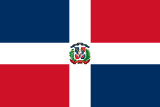Gender Quotas Database

Dominican Republic
Caribbean
Single / Lower House
Cámara de Diputados / Chamber of Deputies
| Total seats | 190 |
| Total women | 70 |
| Percentage of women | 37% |
| Gender Quota target | 40% |
| Election year | 2024 |
| Electoral system | List PR |
| Quota type | Legislated Candidate Quotas |
| Election details | IDEA Voter Turnout - IPU Parline |
| Legal source | Details | |
|---|---|---|
| Quota type: Legislated Candidate Quotas | Electoral law |
Gender equality. Nominations and proposals for candidates for deputies, councillors and members will be governed by the principle of gender equality, so they must be integrated in accordance with the provisions of the law on political parties, groups and movements by no less than forty percent (40%) nor more than sixty percent (60%) of men and women of the national proposal. (Article 142) |
| Legal sanctions for non-compliance | Political Parties Law |
Gender quota. … Paragraph I.- The Central Electoral Board and the electoral boards will not admit a list of candidates for popularly elected positions that contain less than forty percent (40%) and more than sixty percent (60%) of men and women. Paragraph II.- In cases where these obligations are not met, the Central Electoral Board and the electoral boards will return the list to the corresponding party, group or political movement, so that within a period of no more than seventy-two hours they comply with the law, otherwise, applications to political parties, groups and movements will not be accepted in electoral districts where this legal requirement has not been met, and the presentation of candidates by the party, group or political movement in that district will be declared void (Article 53) |
| Rank order/placement rules | Political Party Law |
… Paragraph I. In the event that the need arises to substitute the candidacy of a woman, she may only be substituted in accordance with the internal mechanisms of the party, group or political movement to which she belongs, strictly observing the provisions of article 53 of this law. (Political Party Law, Article 56) |
| Is the provision of direct public funding to political parties related to gender equality among candidates? | No | See more in International IDEA's Political Finance database |
| Are there provisions for other financial advantages to encourage gender equality in political parties? | No | See more in International IDEA's Political Finance database |
Upper House
Senado / Senate
| Total seats | 32 |
| Total women | 4 |
| Percentage of women | 13% |
| Gender Quota target | |
| Election year | 2024 |
| Electoral system | List PR |
| Quota type | |
| Election details | IPU Parline |
| Legal source | Details | |
|---|---|---|
| No data available | ||
Quota at the Sub-National Level
| Quota type | Legislated Candidate Quotas |
| Gender Quota target | 40% |
| Legal source | Details | |
|---|---|---|
| Quota type: Legislated Candidate Quotas | Electoral law |
Gender Equality in Applications for Municipal Offices. … In the candidacies for councillor and his substitutes, the political parties and movements will present 33% of the candidacies of women. In municipalities where only 5 councillors are elected, all candidate proposals must have a minimum of two women. (Local Government Law, Article 34) |
| Legal sanctions for non-compliance | Electoral law | According to the Electoral Law, the lists of the political parties that do not include at least 33% of female candidates will be cancelled and not accepted by the Electoral Commission. |
| Rank order/placement rules | Local Government Law |
Gender Equality in Applications for Municipal Offices. In the proposals for elective positions at the municipal level, the political parties and movements are obliged to preserve and encourage the participation of women, consequently when the candidate for union member is a man, the candidate for vice-union member will be a woman. ... (Article 34) |
Voluntary Political Party Quotas*
| Party | Official Name | Details, Quota provisions |
|---|---|---|
| No data available. | ||
* Only political parties represented in parliament are included. When a country has legislated quotas in place, only political parties that have voluntary quotas that exceed the percentage/number of the national quota legislation are presented in this table.
Additional information
In 1997, Electoral Law No. 275 imposed a 25 per cent quota for women among candidates for elective positions. After the elections in 1998, leaders of political parties negotiated with the Central Electoral Commission that this provision would be interpreted as the obligation to guarantee that women's representation at the national level would not be less than 25 per cent (or 45 of the 179 total number of seats for both houses of parliament). This decision, in effect, removed the burden for each individual party to guarantee 25 per cent women among their parliamentary delegations. In 2000, amendments to the electoral law increased the quota provision to 33 per cent,. In 2002 the legislated candidate quota requirement for the Senate was revoked.
Although elections were planned for May 2020, they have been postponed due to COVID-19 until the 5th of July.
Sources
Legal Sources:
- Constitution of Dominican Republic - Spanish / English
- Election Law - Link
- Political Parties Law - Link
- Local Government Law - Link
Other Sources:
- Parliament of Dominican Republic - Link
- Electoral Commission - Link
- Llanos, B (2019): "Surcando olas y contra-olas. Una mirada paritaria a los derechos políticos de las mujeres en América Latina" Atenea, International IDEA, ONU Mujeres, UNDP.
- Balcacer, A. (2015):"Más allá de los Números: Las Mujeres Transforman el Poder Legislativo en América Latina y el Caribe. Estudio del País: República Dominicana" UNDP in collaboration with the Spanish Government.
- Espinal,R., Galván,S. and Croce, J. (2018): "Más mujeres, más Democracia: Desafíos para la Igualdad de Género en la Política" Santo Domingo: UNDP, JCE and TSE.
Additional reading
- See the latest updates on Dominican Republic on iKNOW Politics
- Morgan, J. , Espinal, R., & Hartlyn, J. (2008). Gender Politics in the Dominican Republic: Advances for Women, Ambivalence from Men. Politics & Gender. 4. 35 - 63. doi:10.1017/S1743923X08000020.
- Gender Equality Observatory for Latin America and the Caribbean: Dominican Republic (Official website)
- Htun, Mala N. 2002. Women in Political Power in Latin America. Manuscript.
- Htun, Mala N. and Mark P. Jones. 2002. ‘Engendering the Right to Participate in Decision-Making: Electoral Quotas and Women's Leadership in Latin America’, in Nikki Craske and Maxine Molyneux(eds) Gender and the Politics of Rights and Democracy in Latin America. New York: Palgrave. pp. 32-56
- Peschard, Jacqueline. 2002. The quota system in Latin America: General review. Manuscript.
- Jimenez Polanco, Jacqueline. 2001. ‘La représentation politique des femmes en Amérique Latine: Une analyse comparée’ (Women's political representation in Latin America: a comparative analysis). Bérengère Marques-Pereira and Patricio Nolasco (eds) La représentation politique des femmes en Amérique Latine (Women's political representation in Latin America). Brussels: L'Harmattan. pp. 27-81.
- Women's Leadership Conference of the Americas. 2001. Women and Power in the Americas: A Report Card. Washington: Women's Leadership Conference of the Americas.
- Htun, Mala N. 1998. Women's Political Participation, Representation and Leadership in Latin America. Issue Brief, Women's Leadership Conference of the Americas.
Explore more resources: Americas | Global
Know about useful additional reading for Dominican Republic? Tell us!
Submit feedback
Submit questions or comments about the Data or Tool
How did you find out about this? What do you like about it? What did you expect but did not find in using the Data or Tool?
To see how we handle your personal data, please read our Privacy Policy.
